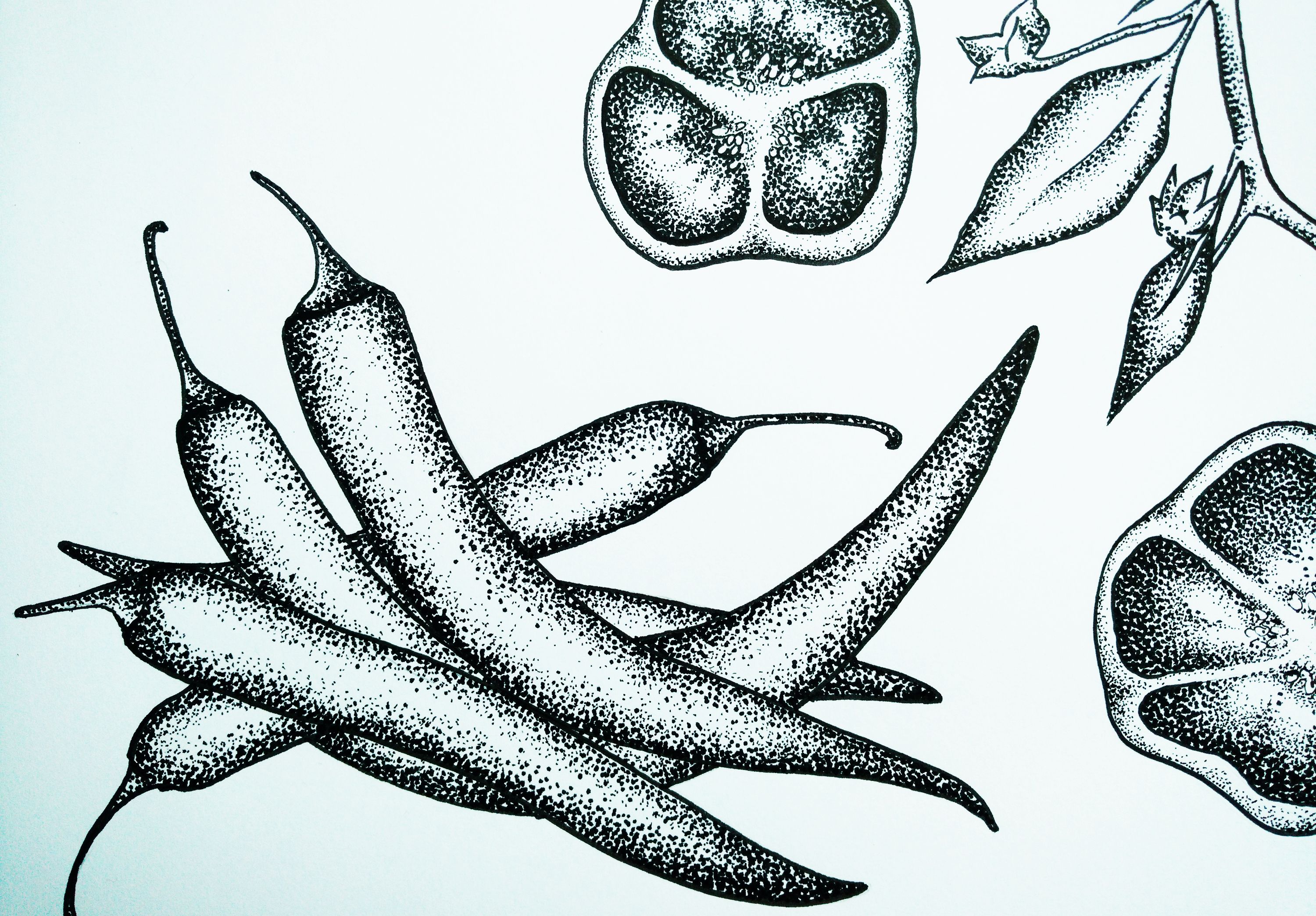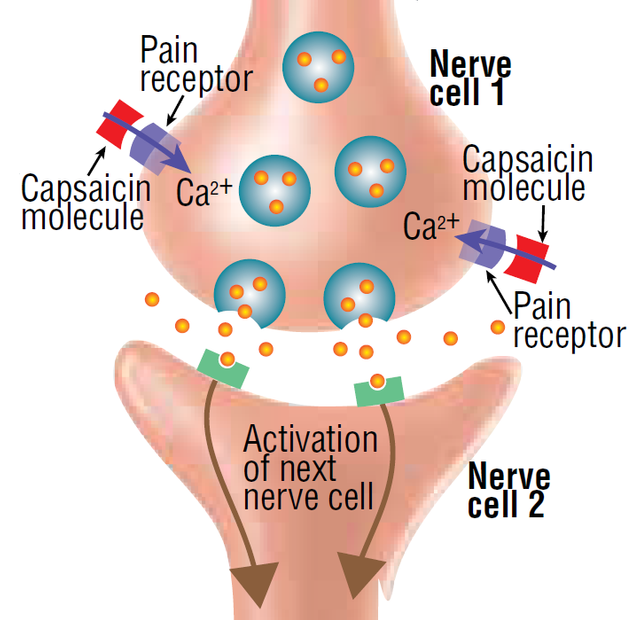Spicy Facts about Hot Peppers and Their Effects

(LAK, Jan 2018)
About six years ago my father - a true spicy food lover - started to seriously work on his spice tolerance as a challenge. He started with jalapeño chili peppers at a starting point of approximately 7,000 Scoville on the scoville heat scale. This is more than what tabasco sauces have, which vary from 2,000 Scoville (original) to 7,000 Scoville (habanero). As a reference: sweet bell peppers have a heat level of max 100 SHU.
After my father integrated the peppers into his diet he soon developed an obsession with trying more challenging and spicier peppers. He slowly worked up his way to the spiciest habanero chiles at the (local) market which measure a level of 400,000 Scoville.
He was fascinated and energized by the rush and euphoria he was constantly getting from the spiciness and he never skipped a day of eating hot peppers. He also introduced me to this whole pepper world.
Two years ago I worked as an intern in the pharmaceutical industry and assisted laboratory workers. The company I worked for produces solely homeopathical drugs so we mainly worked with plants like Capsicum annum which comprises peppers of all sorts! The main chemical component in plants of the species Capsicum annum that is of use is Capsaicin. During my internship I had the pleasure to learn more about it thanks to my colleagues.
So with the knowledge I have now of peppers due to the teachings of my father, my colleagues and the internet I would like to present..
Spicy Facts about Capsaicin
Capsaicin is a unique alkaloid primarily found in the Capsicum genus and is what provides chili peppers its spicy flavor. Extracted pure capsaicin tops the heat scale at 16,000,000 SHU.
It is a powerful irritant for mammals, including humans, and produces a sensation of burning in any tissue with which it comes into contact. Birds, on the other hand, don’t have the same pain sensory pathway as mammals, so they’re immune to capsaicin’s irritating effects. Birds swallow the seeds whole, allowing them to pass through their digestive system without a problem and as a result, they are largely responsible for helping wild peppers spread by eating them and excreting the seeds.[1]
So if capsaicin triggers pain for mammals, aren´t they supposed to detest peppers? Then why do humans continue to consume hot peppers, some of them even consuming large amounts? What are the perks and drawbacks of eating hot peppers? These are the questions I want to tackle today.
Pain and Euphoria: Your Brain on Capsaicin
Surprisingly the “hotness” or “spiciness” of capsaicinoids - related compounds of capsaicin - is not a taste but rather a sensation. There are no taste buds associated with capsaicinoids.

People perceive peppers as 'hot' because when capsaicinoids reach the tongue, they interact with a special type of protein located on the surface of nerve cells. This protein, called TRPV1, acts as a sensor for the cell giving it information about the outside world. Normally, TRPV1 gets turned on by physical heat, like a fire, above 43˚C. This signal will turn the nerve cell on to allow it to trigger other nerve cells that will carry the message to the brain that it has to respond to this dangerous temperature. That ultimately triggers a pain signal that is transmitted to the next cell. So when the cells are exposed to heat, the same events occur.
Chile burns and heat burns are similar at the molecular, cellular, and sensory levels. So as you start chewing on a chili your brain thinks that you’re actually burning the inside of your mouth.[2][3] Now comes the interesting part:
When your body senses pain somewhere like the tongue, that message has to make it to the brain. The message is sent from the location it is initially generated to the brain through a network of neurons by talking to each other via neurotransmitters, which are essentially chemical messages. One such message produced by capsaicinoids is substance P, which transmits pain signals. The brain responds by releasing another type of neurotransmitter known as endorphins.
Endorphins are the body’s natural way of relieving pain by blocking the nerve’s ability to transmit pain signals. Additionally, the neurotransmitter dopamine, responsible for a sense of reward and pleasure, is also released. In essence, for some people eating large amounts of spicy food triggers a sense of euphoria similar to a “runner’s high”.[3]
Health Benefits and Risks of Capsaicin
Nutrients: Chili peppers contain more Vitamin C than oranges, which is essential in tissue repair, immune system enhancement, circulation, brain and mood function. Vitamin B6 and Vitamin B2, or riboflavin, are found in most hot peppers. B6 helps with blood production, nervous system health and hormone function. B6 has been attributed to helping reduce migraine headaches, assisting in enzyme and energy function, and is a strong antioxidant. Most abundant in hot peppers is Vitamin A. It helps red blood cell formation, immune system function, vision health and growth and development.[6]
Pain Relief and Pain Syndrome: Despite the unpleasant sensation that occurs when large quantities of chili peppers are consumed, capsaicin promotes pain relief when used in the right dosage and frequency. When capsaicin is applied to your skin, a steady stream of neurotransmitters is sent to the brain, stimulating pain signals in the body. Once these neurotransmitters are depleted, you no longer experience pain. You are exchanging short-lived intense pain for constant, low-level pain that your body gets used to. Once the nerve cells become depleted of neurotransmitters, they lose their ability to sense pain.[4]
Clinical studies have revealed that three to five topical skin applications per day for periods of two to six weeks have modest beneficial effects against various pain syndromes, including post-herpetic neuralgia, diabetic neuropathy, and chronic musculoskeletal pain. Another topical capsaicin formulation available is the high concentration patch containing 8% capsaicin, which is widely used to treat post-herpetic neuralgia, HIV neuropathy, and other conditions with neuropathic pain symptoms.[2]More Pharmalogical Effects: Previous records suggest capsaicin has multiple pharmalogical effects such as anti-obesity, anti-pruritic, anti-inflammatory, anti-apoptotic, anti-cancer, anti-oxidant, and neuro-protective functions. Moreover, emerging data indicate its clinical significance in treating vascular-related diseases, metabolic syndrome, and gastro-protective effects.[5]
High Concentrations are Toxic: Exposure is painful and even incapacitating. Capsaicin prevents nerve cells from communicating with each other by blocking the production of certain neurotransmitters; at high concentrations it destroys the cells! Capsaicin causes burning or stinging pain to the skin and, if ingested in large amounts by adults or small amounts by children, can produce nausea, vomiting, abdominal pain, and burning diarrhea. Eye exposure produces intense tearing, pain, conjunctivitis, and blepharospasm.Capsaicin's toxicity makes chiles more than just a food- they're also a weapon. Nowadays, capsaicin is the active ingredient in pepper sprays.
Capsaicin as a Doping Substance
Capsaicin is also known to be used as a doping substance in horse racings. What riders do is rubbing the substance on a horse´s legs making them jump higher due to the hypersensitivity. Because of this, capsaicin is classed as doping in equestrian sports and at the events of the 2008 Summer Olympics, four horses even tested positive, leading them to disqualify.[7]
Sources:
[1]Food for Thought / Some Like it Hot, Smells Like Science
[2]Capsaicin: Current Understanding of Its Mechanisms and Therapy of Pain and Other Pre-Clinical and Clinical Uses
[3]This is your Brain on Capsaicin, Helix
[4]Hot Peppers: Muy Caliente!, ACS
[5]Harnessing the Therapeutic Potential of Capsaicin and Its Analogues in Pain and Other Diseases, PubMed
[6]USDA National Nutrient Database
[7]Olympic Horses fail drug tests, BBC
Capsaicin, Wikipedia
Interesting links:
The Chile Pepper Institute
How to Make Pure Capsaicin
The Scoville Scale
I had so much fun writing this and doing a more thorough research on peppers and capsaicin. I hope you enjoyed reading this too and have a better understanding now regarding why people get a rush after eating spicy stuff, why capsaicin can be very beneficial for your body and what happens after you consume large amounts of hot peppers.
Title name inspired by MentalFloss. A shame I didn´t come up with this pun myself!
Being A SteemStem Member
Und mir erzählte man immer Sauer macht Lustig!
Ich habs ja immer geahnt, schon allein als man mir diese Lüge erzählte, Sauer macht lustig, pah! Für mich wars immer schon eindeutig, Scharf, macht, lustig!
Vor allem wenn man mal, diese Habaneros oder Ghostpepper probiert hat, spürt man es einfach, dieses brennen, diese Euphorie, als hätte man einen dauerlauf hinter sich gelassen.
Son Feeling, hatte ich bei Sauren kram immer vermisst...
Nun stellt man sich die frage, ob man selbst auch höher springen oder gar schneller laufen kann, wenn man die Beine mit scharfen Habaneros einreibt.😉
hahahaha diese Frage stelle ich mir auch, wäre es einen Versuch wert? Vielleicht nicht an den Beinen sondern an den Fußsohlen hmmm..
Danke dir!
Für die Wissenschaft!
bisschen gegoogled
An den Fußsohlen?, das erinnert mich an diese eine Sache, Zwiebeln an den Fußsohlen reiben bewirkt das man nach einer halben Stunde Zwiebel geschmack im Mund hat (geruch inclusive).
Entgiften über die Füße... Da gehen die Meinungen auseinander.
Naturheilkunde Rockt!👍😉
Wow, it has many health benefits, but I'm terribly sensitive to hot peppers and gets a runny nose ;) even it makes me sneeze whenever i went near them.
Hey, great post!
I think it could qualify for steemstem-curation, so you should consider editing it to carry the "steemstem" tag (maybe instead of art?)
I resteemed it as well.
Thank you! I changed the tag, thanks for the advice!
hab grad bemerkt, dass du öfter an Wissenschaft grenzende Artikel machst...kennst du @steemstem noch nicht? Ist quasi Pflicht wenn man in dem Sektor schreibt/liest ;-)
oh nein, das kannte ich noch nicht! gut zu wissen, vielen dank für den tipp :D
It does, and it was.
;-)
sehr geil, für mich ne Herausforderung und nur mit viel Übersetzer Arbeit zu lesen aber lohnenswert. Wir ( meine Frau und ich ) LIEBEN Scharfes Essen und kochen selber oft sehr spicy!
Scharfes Essen ist einfach das beste! :D
Verbrennen ohne zu brennen ist auch eine Challenge :D
Aber die Pflanzenwelt steckt schon immer voller Wunder. Da gibt es noch ganz viel zu entdecken.
Gruß Noah
yep! vl entdecken wir ja next week was neues mit dem contest ;)
Hach, ich kann mich noch erinnern als ich Tabasco als absolut mega scharf empfand! Das waren noch Zeiten. Jetzt find ich den geschmacklich einfach nur noch schlimm, dafür werden jetzt jeden Sommer Habaneros angepflanzt. Die sind wenigstens scharf und schmecken auch gut :D
Echt toll recherchierter Artikel. Gerne mehr :)
The only real fact I know abt peppers is they really give u pain in stomach
Ohh ich liebe Schärfe.
Kennst du die Sriracha Sauce?
Mit der geb Ichs mir immer haha
Schöner Beitrag! :)
hahaha ja sriracha ist schon geil!
Very informative in a simple way of explanation.. Know i know better about spices thanks to@lianaakobian! Health is wealth and this content helps me a lot..